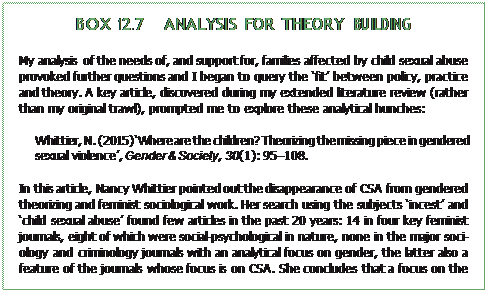 |
Theory building
|
|
|
|
The fifth characteristic of conceptual themes noted by Harding and listed in Box 12. 5 is that they enable the researcher to move beyond identifying findings to building theory. If a theory is a supposition or a system of ideas that are intended to explain something, then a social scientific theory might comprise a set of tested and general propositions that can be expected to be of use as guiding principles that explain and predict certain phenomena.
Citing Grbich (2007), Harding (2013: 109) discusses three levels of theory:
1. Microtheory, which uses concepts to identify common aspects of phenomena.
2. Middle-range theory, which combines concepts with variables and propositions to form explanations with a focus on a particular academic discipline.
3. Grand theory, which combines concepts, propositions and statements that can be applied to a range of academic disciplines.
In terms of criminological theorizing, and according to Akers (2013), there are at least five key features to a good theory. These features can be used as a way of testing out whether or not a particular criminological theory holds good. Akers suggests that to be used for maximum effectiveness, theories must make sense (logical consist- ency), explain as much crime as possible (scope) and be as concise as possible (parsimony). Most important, the theory must be true or correct (validity). Having met these basic goals, the theory must have some real-world applications and policy implications (Akers, 2013: 6–12).
Given the conceptual themes I was finding, and the inconsistencies and discon- nects that appeared to be evident in different elements of the data and in particular between the dominant theoretical framework and policy and practice, it seemed appropriate for me to explore a further level of analysis. I began to ask further ques- tions during my first-level analysis about whether extant theory was adequate. One particular article encouraged me to pursue this avenue of analytical inquiry. Whilst I had used concepts and conceptual themes to identify common aspects of non-abusing family members’ response to, and experiences of, child sexual abuse, and this was interesting at the microtheory level, there were indications that a middle-range the- ory for understanding child sexual abuse might be worth exploring. The hallmarks of my journey towards this level of theoretical analysis and theory building are out- lined in Box 12. 7.
 |

 Having amassed my own findings on the impact of child sexual abuse on non-abusing families, I returned to the existing literature surrounding child sexual abuse. Much of this literature hail from disciplinary areas that criminology rarely expands into. Whittier had already found theorizing from a feminist perspective wanting and my own approach was bringing a criminological-cum-victimological perspective to bear on the problem. Insights from a feminist-inspired victimological perspective were showing that avenues for theoretical development were opening up. How theory connects to practice takes us into the area of praxis. I found holes in some of the crucial elements of theorizing in relation to child sexual abuse. My own assessment is such that:
Having amassed my own findings on the impact of child sexual abuse on non-abusing families, I returned to the existing literature surrounding child sexual abuse. Much of this literature hail from disciplinary areas that criminology rarely expands into. Whittier had already found theorizing from a feminist perspective wanting and my own approach was bringing a criminological-cum-victimological perspective to bear on the problem. Insights from a feminist-inspired victimological perspective were showing that avenues for theoretical development were opening up. How theory connects to practice takes us into the area of praxis. I found holes in some of the crucial elements of theorizing in relation to child sexual abuse. My own assessment is such that:
· theorizing does not have logical consistency in relation to gender and age
· theorizing no longer appears to explain all manifestations of, and contexts for, child sexual abuse
· theorizing in light of the above is therefore not entirely true or correct
· current theorizing is failing in several real-world applications and there may be new directions as regards policy implications.
The final point is about research having the potential to be transformative and to effect change in policy and practice.
|
|
|


